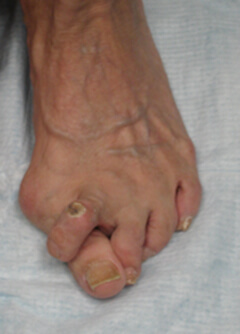Hi Dr. Allen,
I run regularly, about 10km most nights on road and have developed severe metatarsal pain. I have a severe hallux valgus left foot. Insidious onset left foot pain over dorsal surface, around head of met 2/3 possible into tarsal bones too. Nothing visible to see. Hurts when running but I can run through it (particularly on foot strike and push off). I get a severe limp after running and can hardly weight bear for up to 24 hours. Then eases with rest. I had a week off it felt better and then one run back to square one. X-Ray showed nothing. I need your help!
Hi,
It appears that you are suffering from a transfer injury due to compensation while running brought on by your “severe Hallux Valgus left toe”. Hallux Valgus is another way of describing a bunion. When this occurs a runner may transfer some or all of their weight away from the first toe and onto the second during toe-off. The second metatarsal is not designed to handle this repetitive load and over time will result in injury. The specific type of injury to the second metatarsal can be
- Stress fractures. Cause metatarsal pain and limping. Usually will not hurt to stretch toes but will hurt if pressure is applied. They usually do not show themselves on x-ray.
- Bone marrow edema. Cause metatarsal pain and limping. Usually will not hurt to stretch toes but will hurt with applied pressure. Is also known as a “pre-stress” fracture.
- Plantar Plate tear/sprain. Cause metatarsal pain and limping. May cause involved toe to deviate usually towards the big toe. Can be anything from a less severe grade 1 tear to a more severe grade 3 tear.
- Joint capsule tear. Cause metatarsal pain and limping. Will hurt to stretch toes. Also referred to as capsulitis.
- Tendonitis or Tenosynovitis. Can cause metatarsal pain and limping. Will hurt to stretch toes. Is a torn flexor tendon and can be less severe to more severe.
These foot injuries can be debilitating and eventually result in surgery. Early on they can be treated more conservatively using various methods which I will outline for you below.
Conservative Measures for Bunions, Metatarsal Pain and Metatarsal Injuries
- Rest – Rest from running or other impact activities is critical to allow the inflammation in the joints to resolve. If you continuously aggravate your foot it will never get better. Fortunately we now have Altered Gravity Technology (AlterG) which can allow you to run at a lesser body weight. This takes stress off of the joints which in turn stops the aggravation. This ingenious invention allows you to continue to train while your injury heals.
- Custom Orthotics – Custom molds can be taken of your feet and then modifications can be added to offset the pressure from your 1st metatarsal and bunion. Likewise if your pain is beneath your 2nd, 3rd, 4th or 5th Metatarsals a specialized Metatarsal Pad can be expertly placed to take pressure off the painful area. I can not stress how critical it is that the Metatarsal Pad is the right density, height and in the correct location. If the pad is too hard, too thick or in the wrong spot it will not be effective and can actually worsen the situation.
- Taping – There are effective taping techniques to correct the alignment of a bunion and damaged metatarsal joints. We prefer a water proof, elastic athletic tape that can be applied and last for days. Taping technique is crucial in order for it to be effective.
- Platelet Rich Plasma Therapy (PRP) – PRP can be used as a 1x injection into a damaged ligament or tendon to stimulate healing. It is extremely important that following the injection proper rehabilitation techniques must be employed at the correct times during the various phases of healing. Too often people receive PRP injections and then given no guidance on proper rehabilitation only to suffer a relapse and worsening of their injury.
- Proper Shoes – Shoes can make a huge difference when dealing with metatarsal injuries. Narrow shoes tend to aggravate metatarsal conditions due to pressure, rubbing or both. Thin soled shoes do not provide enough cushioning or support. We have found that shoes with a wide toe box and metatarsal rocker technology can significantly help to reduce pressure and pain on the metatarsal joints. Our best results have come with specific models of Hoka and Altra running shoes. We also have recommendations for dress shoes and sandals.
I would suggest that your injury is going from less severe to more severe at this moment. The fact that you get a severe limp and can not weight bear for 24 hours suggests it is worsening and you may be headed towards a more severe injury and possibly foot surgery.
For more information on your metatarsal pain click here
If you would like more information email info@sdri.net or to schedule an appointment call 858-268-8525.
If you would like to do this please follow these directions beforehand
- When you call my office leave your full name and a number and time(s) you will answer so my office can call you back to schedule
- Take pictures and email them to me of your feet while sitting and then standing
- Take pictures of the bottoms of your shoes and email them to me
- Pictures of any insoles you may wear…tops and bottoms and email them to me
The medical information on this site is provided as an information resource only, and is not to be used or relied on for any diagnostic or treatment purposes. This information is not intended to be patient education, does not create any patient-physician relationship, and should not be used as a substitute for professional diagnosis and treatment.


Leave A Comment